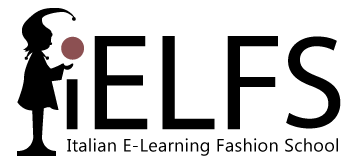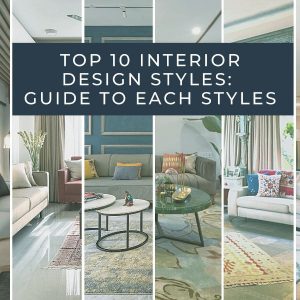
Interior design styles shape the atmosphere of a space and can greatly influence how people feel and interact within it. Each style has unique characteristics, suitable environments, primary colors and textures, and compatibility with other styles. Here’s a detailed look at some popular interior design styles
Want to know more about interior styles?
Study in Italy online on express course «Interior and Home Styling».
After this express course, you will know the difference between various interior
design styles, and learn how to apply them in your interior.
1. Modern Style
Detailed Description:
Modern design is characterized by clean lines, minimalism, and a focus on function. It often features open floor plans and a lack of clutter, emphasizing simplicity and practicality. This style avoids ornate details and prefers sleek, streamlined furniture.
Primary Colors and Textures:
- Colors: Neutral colors like white, black, gray, with occasional bold accents (e.g., red, blue).
Textures: Smooth surfaces, metal, glass, polished wood.
Suitable Environments:
- Ideal: Open spaces, lofts, urban apartments.
Not Ideal: Traditional homes with intricate architectural details.
Compatibility:
- Can Combine With: Industrial, Scandinavian.
Should Avoid: Rustic, vintage

2. Contemporary
Detailed Description:
Contemporary design focuses on current trends and styles, which can evolve over time. It emphasizes open spaces, light, and a balance between comfort and sophistication. The design often features a mix of new and old elements, creating a fresh, updated look.
Primary Colors and Textures:
- Colors: Neutral palettes with bold, contrasting colors.
- Textures: Clean lines, smooth surfaces, a mix of materials including metal, glass, and wood.
Suitable Environments:
- Ideal: Urban apartments, modern homes, commercial spaces.
Not Ideal: Historic homes with period details.
Compatibility:
- Can Combine With: Minimalist, industrial.
Should Avoid: Classic, traditional.

3. Minimalist
Detailed Description:
Minimalist design is all about simplicity and functionality. It eliminates unnecessary elements and focuses on clean lines, open spaces, and a monochromatic color palette. Every piece of furniture and decor has a purpose and contributes to the overall harmony of the space.
Primary Colors and Textures:
- Colors: Monochromatic, often white or light neutrals.
- Textures: Simple, uncluttered, functional, use of natural light and open spaces.
Suitable Environments:
- Ideal: Small apartments, studios, offices.
Not Ideal: Large homes with lots of space to fill.
Compatibility:
- Can Combine With: Scandinavian, modern.
- Should Avoid: Bohemian, eclectic
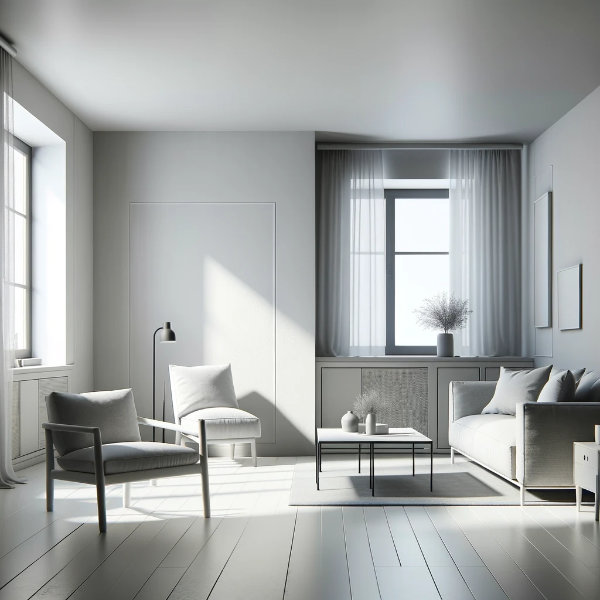
4. Scandinavian
Detailed Description:
Scandinavian design combines simplicity, functionality, and beauty. It emphasizes natural light, muted tones, and clean lines. The style often includes cozy textiles, wooden elements, and a minimalist approach to furniture and decor
Primary Colors and Textures:
- Colors: Light colors, often white with pops of pastel or muted colors.
- Textures: : Natural materials like wood, wool, and linen, functional furniture with clean lines.
Suitable Environments:
- Ideal: Small to medium-sized homes, apartments.
Not Ideal: Spaces requiring bold, dramatic designs.
Compatibility:
- Can Combine With: Minimalist, modern.
- Should Avoid: Industrial, maximalist.
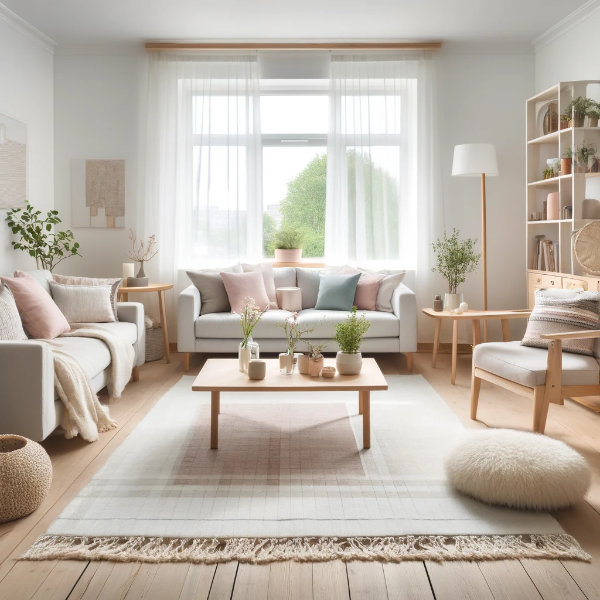
5. Industrial
Detailed Description:
Industrial design draws inspiration from old factories and industrial spaces. It features exposed brick walls, metal beams, and wooden elements. The style often incorporates raw, unfinished materials and a neutral color palette, creating a rugged and functional aesthetic.
Primary Colors and Textures:
- Colors: Neutral tones, often shades of gray, black, and brown.
- Textures: Exposed brick, metal, wood, raw and unfinished elements.
Suitable Environments:
- Ideal: Lofts, converted warehouses, urban spaces
Not Ideal: Cozy, small homes.
Compatibility:
- Can Combine With: Modern, rustic.
- Should Avoid: Traditional, classic

6. Bohemian
Detailed Description:
Bohemian (or boho) design is eclectic and full of vibrant colors and patterns. It emphasizes a free-spirited, artistic lifestyle, combining various textures, vintage furniture, and lots of decorative items like rugs, pillows, and plants.
Primary Colors and Textures:
- Colors: Rich, vibrant colors, often mixed together.
- Textures: Eclectic mix, including fabrics, patterns, plants, and vintage items.
Suitable Environments:
- Ideal: Artistic spaces, relaxed homes, creative studios.
Not Ideal: Formal, structured spaces.
Compatibility:
- Can Combine With: Vintage, eclectic.
- Should Avoid: Minimalist, modern.
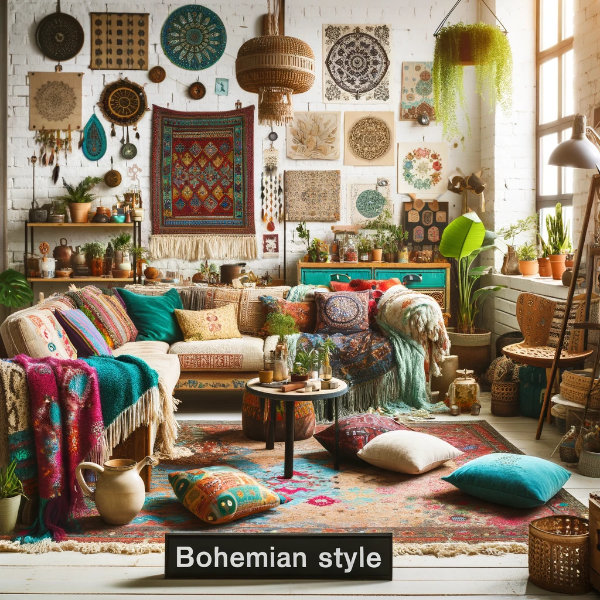
7. Rustic
Detailed Description:
Rustic design emphasizes natural beauty and ruggedness. It features earthy colors, raw wood, stone, and other natural materials. The style creates a warm and cozy environment, reminiscent of a countryside or cabin setting.
Primary Colors and Textures:
- Colors: Earthy tones, such as browns, greens, and muted reds.
- Textures: Natural materials like wood and stone, rough-hewn finishes.
Suitable Environments:
- Ideal: Cabins, countryside homes, cozy interiors.
Not Ideal: Urban apartments, ultra-modern spaces.
Compatibility:
- Can Combine With: Industrial, vintage.
- Should Avoid: Contemporary, minimalist.
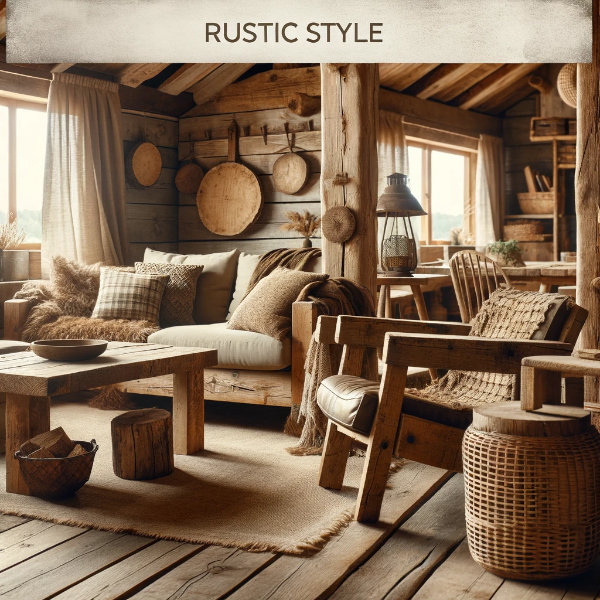
8. Traditional
Detailed Description:
Traditional design is classic and timeless, inspired by European decor from the 18th and 19th centuries. It features rich colors, ornate details, and elegant furniture. The style emphasizes harmony, symmetry, and a sense of comfort and order.
Primary Colors and Textures:
- Colors: Rich, deep colors like burgundy, navy, and dark green.
- Textures: Ornate details, wood, elegant fabrics like silk and velvet.
Suitable Environments:
- Ideal: Historic homes, formal living rooms, dining rooms.
Not Ideal: Modern apartments, casual spaces.
Compatibility:
- Can Combine With: Classic, vintage.
- Should Avoid: Minimalist, industrial.

9. Vintage
Detailed Description:
Vintage design embraces the charm and character of past eras. It incorporates antique furniture, floral patterns, and delicate fabrics. The style creates a nostalgic and romantic atmosphere, often featuring unique and one-of-a-kind pieces.
Primary Colors and Textures:
- Colors: Soft, pastel colors mixed with bold accents.
- Textures: Antique furniture, floral patterns, delicate fabrics.
Suitable Environments:
- Ideal: Bedrooms, living rooms, boutique shops.
Not Ideal: Ultra-modern spaces, high-traffic areas.
Compatibility:
- Can Combine With: Bohemian, rustic.
- Should Avoid: Contemporary, minimalist.

10. Eclectic
Detailed Description:
Eclectic design is all about mixing and matching different styles, colors, and textures. It allows for personal expression and creativity, combining various elements to create a unique and personalized space. The style is vibrant, bold, and often unconventional.
Primary Colors and Textures:
- Colors: A mix of various colors, often bold and vibrant.
- Textures: Diverse materials, unique and unexpected combinations.
Suitable Environments:
- Ideal: Creative spaces, artist studios, personal homes.
Not Ideal: Formal or highly structured environments.
Compatibility:
- Can Combine With: Bohemian, rustic.
- Should Avoid: Minimalist, traditional.
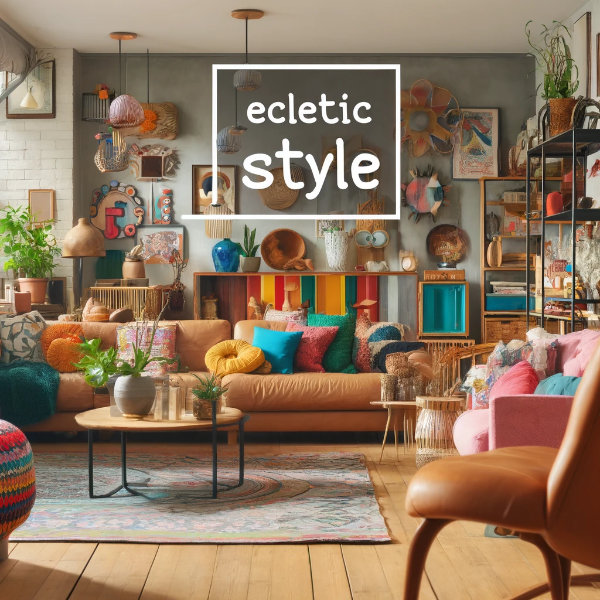
Conclusion
Understanding the characteristics and suitable environments for each interior design style can help you create spaces that are both functional and aesthetically pleasing. While some styles blend seamlessly, others are best kept separate to maintain their unique appeal. By carefully selecting and combining design elements, you can achieve a harmonious and personalized interior.
